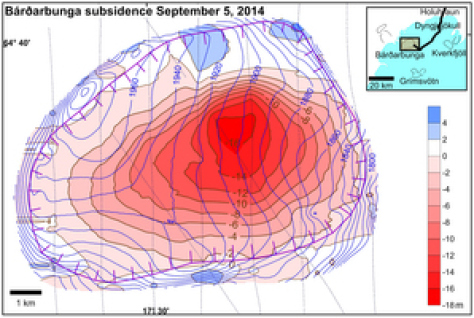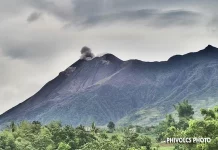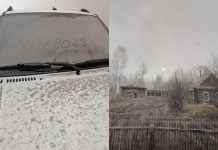The CALDERA IS COLLAPSING at Bardarbunga!
And this on top of the confirmed lava flow activity!

According to a new report from volcanologists, Bárðarbunga’s caldera is sinking:
[quote_box_center]Yesterday, 18 December, scientists flew over Bárðarbunga. The data collected in the flight show that the subsidence of the caldera continues with similar rate as before and amounts to about 56 m in total from the onset of the unrest. The total volume of the caldera subsidence is estimated to be about 1.7 km³.[/quote_box_center]
The reports states that about two kilometers of caldera has subsided by 56m / 183 feet since the beginning of the volcanic eruption.
The real apocalypse will then occur when the weight above exceeds the support of the chamber below. Then, the entire area will collapse rapidly.
And as we’ve seen in OTHER collapses, when the surface collapses into the emptying caldera, a large eruption ensues. Here an example of the 2011 Pu’u’ O’o’ caldera collapse in Hawaii:
The report again says:
[quote_box_center]The volcanic eruption has now been going on for over three months, the lava flow is still great in Holuhraun and the rate of the subsidence of the Bardarbunga caldera is still significant.
Three scenarios are considered most likely:
1. The eruption in Holuhraun continues until the subsidence of the Bardarbunga caldera stops. The eruption can still go on for many months.
2. The volcanic fissure may lengthen southwards under Dyngjujokull, resulting in a jokulhlaup (rapid glacier meltoff) and an ash-producing eruption. It is also possible that eruptive fissures could develop in another location under the glacier. If such an eruption would be prolonged it could eventually produce a lava flow.
3. Volcanic eruption in the Bardarbunga caldera. Such an eruption would melt large quantities of ice, leading to a major jokulhlaup, accompanied by ash fall. [/quote_box_center]
Well it seems that something big will happen within the next weeks or months at Bardarbunga… And it will probably shake the world!












